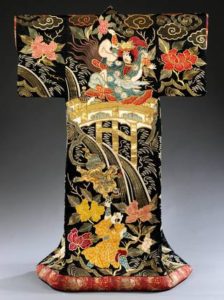Image Source:
Image Caption:
Tags: kimono, kabuki, Japan
This traditional kimono is part of the Japan collection at the V&A museum in London. It was made to be worn by a performer of the traditional Japanese theatre known as Kabuki. Kabuki is known as one of three major types of classical theatre in Japan, along with Noh and Bunraku and has its roots in the Edo period (1603 – 1868 in Japanese history).
Kabuki theatre makes use of elaborate costumes and wigs and uses a very old fashioned form of Japanese which is difficult to understand, meaning the actors make use of stylised movements to help tell the story. The Kabuki makes use of very intricate sets including trapdoors and sometimes even a footbridge going into the audience. The plots largely consist of similar themes that western theatres show such a historical events, love stories and tragedies. What is different about Kabuki plays is that they only show a part of the story, usually the most interesting part, which means that to enjoy the show it is beneficial to read up on the story beforehand.
The kabuki has an interesting history, originally it was a form of theatre only performed by women, and a lot of the performers were also prostitutes. This eventually caused female Kabuki to be banned for being too erotic. Today it is performed by men exclusively, and certain male actors end up specialising on the female parts.
This kimono is such an interesting object, not only because it is so beautiful, but because it tells a story about a fascinating cultural form with a long history.
-Danielle Triggs
Junior Girl
Girl Museum Inc.

